A TB Action Plan For Scotland: ANNUAL REPORT / 2013
This is the first Annual Report of the TB Action Plan for Scotland.
Annex C: Evaluation of TB control in Scotland
Background
A Framework Action Plan to fight tuberculosis in the European Union1 was launched by the European Centre for Disease Prevention and Control (ECDC) in 2008. The ECDC has also produced a follow-up to the Framework Action Plan2, the objectives of which are: to provide an overview of the current strategic environment for tuberculosis control in the EU and outline how this relates to the global situation; and, to describe an epidemiological and strategic monitoring framework that would allow progress towards elimination of TB in the EU to be assessed.
On World TB Day 2011, the Scottish Government launched An Action Plan for TB in Scotland.3 The intention of the TB action plan is to ensure that Scotland provides the best quality clinical, laboratory and public health services in relation to TB, and that those are underpinned by the best possible surveillance and epidemiology. The TB Action Plan summarises the issues considered by the working group and subgroups and detail the recommendations that have been made as a result. Recommendation 14a of the Action Plan states that 'HPS should continue to report annually to the Scottish Government (copied to NHS boards) on TB. This report should include a section describing Scotland's performance against the specific ECDC indicators'.
Progress in Scotland
In this report, we monitor the progress in Scotland towards the elimination of TB using these indicators and targets. This report includes progress on both the epidemiological markers (Table 1) and the core indicators (Table 2). This evaluation should be read in conjunction with the 2013 TB Annual Report for Scotland, which provides a more comprehensive epidemiological report of TB in Scotland.4
Epidemiological markers
Scotland successfully met two of the four epidemiology indicators or targets recommended by the ECDC (shown in green, Table 1); there was a decreasing trend in notification ratio of rates in children to adults and a mean declining trend in MDR-TB rates. Two indicators or targets were not met (shown in red, Table 1). The five year trend in case notifications is generally increasing. However, there was a decrease in both the number of cases and incidence of tuberculosis reported in Scotland in 2011 and 2012 so the five year trend may begin to decrease if case numbers continue to fall. The overall trend in the mean age of cases continues to decrease, driven by a decrease in those born outside the UK as the mean age of cases born in the UK is increasing.
Core indicators for the framework action plan
Scotland successfully met seven of the ten core indicators recommended by the ECDC, (shown in green, Table 2); availability of a national TB control plan, availability of guidelines for implementing the national TB control plan, the national reference laboratory achieves an adequate performance in an external quality assurance scheme, availability of a strategy for introducing and implementing new tools for TB control, more than 80% of pulmonary cases were confirmed by culture, more than 70% of pulmonary MDR-TB cases successfully completed treatment at 24 months and Scotland reported TB treatment outcomes to ECDC. One indicator was not met in Scotland (shown in red, Table 2); less than 85% of pulmonary cases successfully completed treatment at 12 months. Two indicators were partially met (shown in amber, Table 2); less than 100% of cases confirmed by culture had drug sensitivity testing undertaken for the first-line drugs and real time reporting on the HIV status of TB cases is not currently possible in Scotland.
Discussion
In 2012, 9/14 (64.3%) of ECDC indicators or targets were met in Scotland which demonstrates improved performance in two areas (more than 80% of pulmonary cases were confirmed by culture, treatment success of 70% at 24 months for new culture positive pulmonary MDR cases) and reduced performance in one area (the percentage of culture confirmed cases for which drug sensitivity testing was carried out for first line drugs) when compared with 2011. However, there have been improvements in other key areas since the publication of the TB Action Plan for Scotland. In 2012, there was a continued reduction in the number and incidence of TB in Scotland reported since 2010. If this downward trend continues then as a consequence the five year trend will also begin to decrease. Although the overall mean age of TB cases continues to decrease in Scotland, the mean age of UK born cases is increasing. Non-UK born cases are younger than UK born cases and their mean age is decreasing and non-UK born cases now account for more than half of all cases reported. In 2012, HPS carried out data linkage to determine the HIV status of TB cases. Although these linked data are not available in real time (and therefore not yet available for 2012), it provides valuable information on the burden of HIV among TB cases in Scotland. Furthermore, recommendations made in the TB Action Plan to implement a dynamic and real time surveillance system should help to improve performance on treatment completion at 12 months.
References
1. European Centre for Disease Prevention and Control. Framework Action Plan to fight tuberculosis in the European Union. Stockholm: ECDC; February 2008.
2. European Centre for Disease Prevention and Control. Progressing towards TB elimination. Stockholm: ECDC; 2010.
3. A TB Action Plan for Scotland. The Scottish Government, Edinburgh 2011.
4. McDonald, E, Smith-Palmer, A., Johnston, F., Smith, M., Laurenson, I.F., and Donaghy, M. Enhanced Surveillance of Mycobacterial Infections (ESMI) in Scotland: 2013 Tuberculosis Annual Report for Scotland. Health Protection Scotland Weekly Report; 2013.
Table 1: Epidemiological markers

Table 2: Core indicators for the framework Action Plan


Contact
Email: Janet Sneddon
There is a problem
Thanks for your feedback